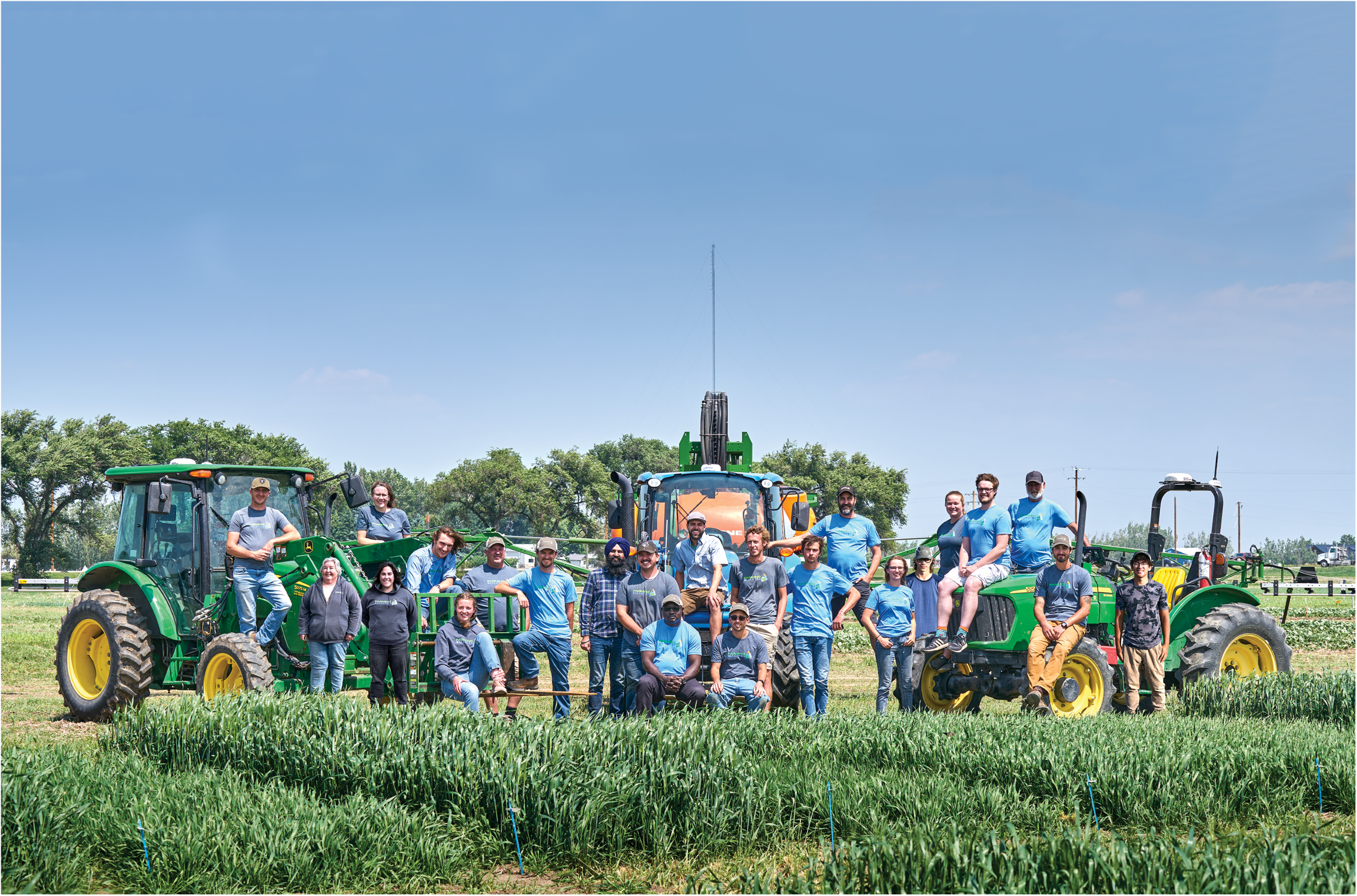Applied Crop Production Research Across the Canadian Prairies

There is world-class government and academic research conducted throughout the Canadian Prairies. To adapt government and academic research to local growing environments, there is a broad network of organizations across Alberta, Saskatchewan, and Manitoba that conduct applied research and demonstrations. This article provides an overview of the provincial networks and highlights one organization from each province to showcase the value of applied research that is being conducted across Western Canada.
There is world-class government and academic research conducted throughout the Canadian Prairies; however, Western Canada spans a large geography, across multiple soil types and climatic conditions. As all CCAs, agronomists, and soil scientists know, implementing academic research requires local and applied study.
To adapt government and academic research to local growing environments, there is a broad network of organizations across Alberta, Saskatchewan, and Manitoba that conduct applied research and demonstrations (Figure 1).
This article provides an overview of the provincial networks and highlights one organization from each province to showcase the value of applied research that is being conducted across Western Canada.

Manitoba Diversification Centers
Well defined by their tagline, “Manitoba farms. Manitoba Research,” these producer-directed, nonprofit associations conduct applied research and demonstrations to advance primary crop production in the province’s main agro-climatic regions and soil types. The four Manitoba diversification centers are located at Roblin (Parkland Crop Diversification Foundation), Melita (Westman Agricultural Diversification Organization), Carberry (Manitoba Diversification Center), and Arborg with a satellite location in Beausejour (Prairies East Sustainable Agricultural Initiative Inc.).
The Manitoba Diversification Centers (mbdiversificationcentres.ca) aim to:
• Make farms more profitable, sustainable, and adaptable.
• Have research innovations more quickly adopted on farms.
• Aid in the adoption of technical innovations or practices from other farming regions.
• Grow the agriculture, agri-food, and agri-product sector.
Underpinning these goals is an extension mandate to ensure producers are informed about new project results, technical information, and new opportunities.
Spotlight on Westman Agricultural Diversification Organization—Melita, MB
Diversification aptly describes Westman Agricultural Diversification Organization (WADO). Under the highly efficient leadership of Scott Chalmers, the WADO Applied Research Specialist and Manitoba government employee, WADO is at full capacity.
In 2024, they are running 50 trials spanning many crop types: wheat, barley, corn, soybean, sunflower, pea, dry bean, lupin, hairy vetch, hybrid hemp, flax, and mustard. Located in the southeast corner of Manitoba, with a home base at Melita, this small, hard-working team of four full-time staff and three summer students are efficiency experts. The logistics of growing such diverse crop species requires a great range of knowledge and expertise when you consider each crop’s rotational needs, pesticide requirements, crop-staging intricacies, optimal seeding, fertility needs, and harvest times.
Although incredibly complicated, WADO thrives in this setting and has an impressive track record. They are the “go-to” collaborator for western Canada’s most prestigious academic and government researchers, including Yvonne Lawley, Martin Entz, Syama Chatterton, and Linda Gorim. With base funding from the provincial government, Chalmers and the farmer board have grown WADO from a “raccoon-infested, chip-board shed” to a leader in applied research over the past 17 years.
Approximately two-thirds of WADO’s trials support variety development from Agriculture and Agri-Food Canada, the University of Manitoba, the University of Saskatchewan's Crop Development Center, and General Mills, along with variety evaluation for the provincial seed guide, Manitoba Crop Alliance, and Manitoba Pulse & Soybean Growers.
Although the Manitoba Crop Variety Evaluation Trials (MCVET) and breeder registration trials are the bulk of their work, some of WADO’s highest-impact trials are seeking solutions to timely challenges around Aphanomyces root rot, Fusarium head blight, and validating the effectiveness of enhanced-efficiency fertilizers.
According to Chalmers, the secret to success is timely communication. This mindset enables WADO to “do something good and be environmentally sound.” As a further testament to their quality, WADO is also known to produce high-quality professional staff with a tremendous work ethic and knowledge base that is highly sought after by other agricultural institutions.
Like all great organizations, WADO has an eye towards growth. The wish list includes a new building and increased partner funding. With those resources, WADO would like to expand into other high-impact applied research such as variable-rate seeding, fertility, and intercropping.
Saskatchewan’s Agri-ARM Sites
Eight Agri-ARM (Applied Research Management) sites span the vast agricultural production zones of Saskatchewan. They are located in Scott (Western Applied Research Corporation), Swift Current (Wheatland Conservation Area Inc.), Outlook (Irrigation Crop Diversification Corporation), Prince Albert (Conservation Learning Center), Melfort (Northeast Agriculture Research Foundation Inc.), Indian Head (Indian Head Agricultural Research Foundation), Yorkton (East Central Research Foundation), and Redvers (South East Research Farm).
The Saskatchewan Agri-ARM sites aim to:
• Increase adoption of new agricultural production technologies and practices.
• Give farmers more tools for environmental and economic decision-making.
• Develop and maintain infrastructure and expertise for regional applied research and demonstration.
• Highlight agriculture’s role in environmental stewardship and the overall economy to the general public.
• Provide unbiased, third-party results at field days, producer meetings, workshops, online, and to Indigenous communities.

Spotlight on Indian Head Agricultural Research Foundation—Indian Head, SK
The small town of Indian Head, SK, is home to a powerhouse of research and technology transfer. The Indian Head Agricultural Research Foundation (IHARF) provides reliable, unbiased, and regionally relevant information for farmers in southern Saskatchewan and throughout the Northern Great Plains.
Under the direction of Chris Holzapfel, IHARF Research Manager, and other team members, this group has just celebrated 30 years of managing small-plot trials, on-farm trials, and extension demonstrations. The long-term, dedicated staff and a high-caliber board of directors ensure the organization stays relevant and well connected within the industry. With a team of five full-time, three seasonal, and one external employee, this team grows 2,000–2,500 individual small plots and numerous on-farm field-scale trials each year.

Holzapfel has a strong background in fertility research, but IHARF’s open-minded attitude diversifies their work based on the agronomic issues of the day. This includes trials on seeding dates, seeding rates, row spacing, rotations, residue management, variety responses to input and management practices, integrated weed management, crop tolerance trials, crop competition, product testing, and more.
Testing of new or non-conventional crop inputs is work that is always in high demand. Producers want to understand the value of these products, and companies want to understand the performance of these products in specific geographies.
One of the biggest struggles facing applied research groups is access to uniform land that is well-suited for research. The Indian Head Agricultural Research Foundation has an impressive full section of land (640 acres). With this important asset, a piece of land only sees plots once every four to five years. This ensures that variability from previous treatments or compaction is minimized.
To further minimize variability, IHARF is very selective of the field-scale trials it runs on its core research land, as it does not want to introduce artificial background variability. The objective is to keep residual nutrient levels reasonably low and as uniform as possible on the IHARF-owned land. Therefore, trials with fertility rates or different fertilizer products are generally conducted on non-IHARF-owned land.
The positive feedback and good value that producers see from IHARF cannot be achieved in isolation. The foundation has a close working relationship with Agriculture and Agri-Food Canada’s Indian Head Research Farm. It has a healthy mix of funding from the federal government, provincial government, producer commodity groups, and private industry.
Relationships with funders, other Agri-ARM sites throughout Saskatchewan, commodity groups, and agricultural writers are leveraged to disseminate IHARF’s research findings. It is no surprise that Chris Holzapfel is a familiar guest speaker at third-party meetings, IHARF summer field days, and the IHARF winter seminar.
Alberta’s Applied Crop Production Research
Applied crop production research in Alberta is structured differently than in Saskatchewan and Manitoba. There are two unique groups, Farming Smarter at Lethbridge and SARDA Ag Research at Falher. Additionally, five Agricultural Research and Extension Council of Alberta (ARECA) members work on applied crop research and extension.
Members of ARECA are located in Forestburg (Battle River Research Group), Westlock (Gateway Research Organization), Fort Vermilion (Mackenzie Applied Research Association), Manning (Northern Peace Applied Research Association), and Oyen (Chinook Applied Research Association).
Although independent, the Alberta organizations aim to:
• Identify the local needs and challenges of producers.
• Collaborate with specialists.
• Translate and transfer knowledge.
• Improve the agricultural economy.
Spotlight on Farming Smarter—Lethbridge, AB
Serving 14 Alberta municipalities south of Highway 1, Farming Smarter is de-risking innovation for farmers. Executive Director Ken Coles, under the leadership of a competency-based board, has flipped the traditional applied research association model on its head and is achieving great things.
With 11 full-time employees and up to 16 seasonal staff, Farming Smarter’s passionate and engaged team is making a meaningful impact for southern Alberta producers. They have an organizational culture that makes science relatable, and they achieve real outcomes in four key program areas:
Agronomy Research – Focuses innovation on things like novel crops, cover cropping, crop management for soil health, carbon sequestration, and agronomic best management. This is the platform for testing shiny, out-there ideas.
Field Tested – Provides on-farm research services and is branching into the underserved, high-value irrigation sector. With new commercial partners, Farming Smarter is building capacity in high-value crops and adding a sustainability lens to ensure research is adapted to the real-life context of field-scale production.
Commercial Innovation – Encompasses unbiased, third-party, contract-type research. This program ensures Farming Smarter is connected to the latest industry innovations.
Knowledge and Network – This value-added, subscription model is always revamping and engaging members. It is not simply field days and factsheets but includes videos and very active public dissemination through Open Farm Days, a website, social media (including YouTube videos), and popular press articles. This program creates a feedback loop to continually inform the research program with new priorities.
In reinventing the model, Farming Smarter uses research and extension as tools rather than objectives to drive innovation. After the provincial government exited the research and extension space, Farming Smarter has grown exponentially. Land is one of their biggest constraints as the group manages more than 200 small-plot trials per year. This rapid expansion highlights the crucial role Farming Smarter plays in innovation development and adoption.
To achieve stable and secure funding, Farming Smarter has traditional, mutually beneficial collaborations with the provincial government, federal government, and academia. However, it has also built new, refreshing relationships with philanthropic partners such as the Westin Foundation, RBC Tech for Nature, and Farmers for Climate Solutions. These partnerships enable Farming Smarter to address sustainable agriculture and climate change work that benefits southern Alberta farms. With this fresh approach, Farming Smarter is innovating the innovation model.
From Applied Research to the Agronomist
Certified Crop Advisers, agronomists, and soil scientists in Alberta, Saskatchewan, and Manitoba benefit from the work of applied crop production research associations. These groups play an essential role in variety evaluation, the adaptation of agronomic management practices to local geographies, and de-risking innovation. Crop production is big business, and ensuring that academic concepts are effectively adapted to the field is essential to everyone’s success.
Text © . The authors. CC BY-NC-ND 4.0. Except where otherwise noted, images are subject to copyright. Any reuse without express permission from the copyright owner is prohibited.











